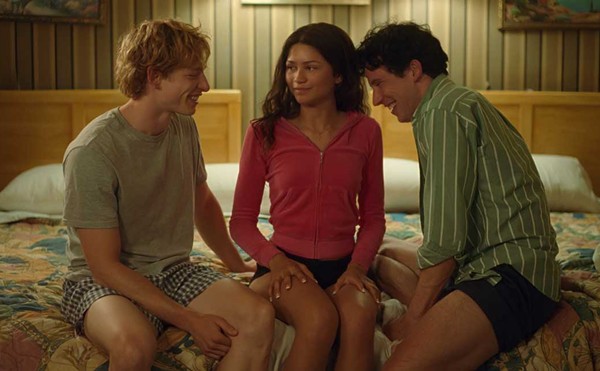Fleeing the past, the Sullivan family leaves Ireland to sneak into the United States, arriving in the last place that needs four more Irish: New York City. They rent a flat in a junkie-infested apartment building in Lower Manhattan. Although he works hard to get acting work, youthful patriarch Johnny Sullivan (Paddy Considine) takes a job as a cab driver. His wife, Sarah (Samantha Morton), gets work in an ice cream shop. They trade off taking care of their two young daughters, Ariel and Christy (real-life sisters Sarah and Emma Bolger).
But the past is close on their heels. The family is still mourning the death of 2-year-old Frankie Sullivan. Every so often this sense of loss is expressed in tears and anger, though mostly in the emotional distance and worried protectiveness of Johnny.
This would be merely a family melodrama if not for the Sullivans’ neighbor, Mateo (Djimon Hounsou), a painter tormented not by his past but by his future. Mateo’s passion for life helps the Sullivans come to terms with their loss, and his downward spiral is an almost perfect inversion of the coming of their tiny preemie baby.
The acting shines, and if the convincing and moving performances are the movie’s fingers, the photography balls them up into a potent fist. In one remarkable scene, the unvarnished peasant beauty of Morton is adeptly photographed in extreme close-up, calling to mind the powerful, almost iconic imagery of Carl Dreyer’s classic Jeanne d’Arc. And whenever Hounsou appears to deliver a few understated but show-stealing lines of dialogue, his feverish, sweat-beaded skin shimmers with vitality.
But the film is marred by surprising fumbles that we wouldn’t expect from Jim Sheridan, the director of the acclaimed My Left Foot. For instance, those of us west of Hoboken understand that America is a vast land of fantastic variety. Only the most arrogant New Yorker or the most oblivious foreigner would blunder so badly as to regard New York as the quintessential American city. And yet, this Anglo-Irish picture, set in Manhattan, is audaciously titled In America.
This semiautobiographical film is loosely based on writer-director Sheridan’s experience. As suggested by the largely pre-1990 pop sound track, Sheridan’s time in New York was somewhere back in the Koch administration. All of this makes In America a sort of period film mistakenly set in the present. And the savvy viewer will become painfully aware that Sheridan hasn’t the faintest idea what New York is like in 2003. Many plot points are embarrassing anachronisms: Not only does this poor family decide to live in now-pricey Lower Manhattan, but the white protagonist gets a job as a taxi driver, today the province of Third World immigrants.
And for a film about a young family struggling to make ends meet in the most expensive city east of San Francisco, there is a surprising lack of class angst. To scrimp along amid affluence can make even the most optimistic immigrant realistically indignant — and that’s a vital part of the New York experience! The Sullivans’ hopeful outlook often makes them look like rubes, and it’s difficult to sympathize with the blithely ignorant.
What’s more, in post-9/11 America, the immigration angle is so relevant, so important, that the socially conscious viewer will likely be baffled to find it only briefly touched upon. These illegal residents somehow are able to get jobs and enroll their children in school without a care in the world.
That said, those unfamiliar with the real New York will probably accept the imaginary world Sheridan presents as genuine enough. He may not know contemporary Manhattan, but he probably has shrewdly estimated his audience: British and Irish art house audiences who wish they could live out their American fantasies.
As we might expect from a director writing his own screenplay, we have some too-blatant storytelling techniques. The film is narrated by an apparently omniscient 10-year-old who is wise before her years, roving around with a camcorder and making poignant, witty observations. The episodic plot and meandering character arcs are difficult to tie together, and Sheridan resorts to clichés of moviemaking in an effort to make things work, using disconnected monologues and snowball fights choreographed over a music a la MTV. Then there’s the bald symbolism and spell-it-out sound track selections that, just in case you didn’t get it, dutifully hammer home every point the screenwriter could better have made with plot and structure.
Yes, those kids are cute little devils. Yes, childhood is as magical as parenthood is harrowing. But the things that make In America a moving experience are the same things that could take place anywhere. It’s admirable that Sheridan wanted to tell his American story, but a host of avoidable mistakes lower this well-meaning family melodrama to the level of make-believe.
Showing at the Birmingham 8 (Old Woodward, south of Maple, Birmingham). Call 248-644-3456.
E-mail Michael Jackman at [email protected].





